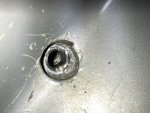FatSacMikey
Cadet
- Joined
- Aug 30, 2020
- Messages
- 7
Hello all,
This is my first post here, but let me first say that we (my wife and I) have been consulting these forums for the 4 years we've owned this boat and you guys have been a huge help for all of our undertakings. Many thanks and lots of respect for everything you guys do.
I'm in some undocumented territory right now, so I wanted to get some professional opinions on how to proceed.
The technical specs...
2000 Chapparal Sunesta 223 Sterndrive
Engine:
1. The bearing carrier feels rough when rolling starting at about the 6-7 in-lb point. It gets progressively rougher as we get to the 10 in-lb point, and it's making it difficult to get a reading as the torque gauge dial is jumpy. See video link at bottom. Is this roughness normal, or should we expect smooth rolling all the way up to the specified rolling torque?
2. As we were cleaning up for the day, I found the little spring that goes around the lip of the input shaft seal in my pocket (it must have fallen off when I had the seal in my pocket earlier that day). To get this spring back on the seal, we'll have to again remove the driveshaft from the bearing carrier, put the spring in place, reassemble, and set the rolling torque. I understand we're supposed to replace the pretension sleeve when the driveshaft is removed, but will this be necessary in this case given that the pretension sleeve has not been used at all? If it is, I'm thinking I can just buy myself a hydraulic press for the cost of another hour of labor and do it myself. It would be ideal if we could just reassemble, set the rolling torque again, and be on our way, but I don't want to risk a gear unit meltdown.
Some notable pics I've taken throughout the process:
Gimbal bearing in place, rust can be seen inside engine coupler:
https://photos.app.goo.gl/fAaAHkyTb5fRiz3c7
Destroyed gimbal bearing vs. new gimbal bearing:
https://photos.app.goo.gl/XxvSKZCXcxC2xWWV6
Inner part of gimbal bearing fused to driveshaft:
https://photos.app.goo.gl/w3VdUrrTyDsGyPeG7
Old driveshaft vs. Volvo Penta's new driveshaft:
https://photos.app.goo.gl/rayyMAUPXyfaVTYB6
Bonus pic - strange gash in upper gear housing:
https://photos.app.goo.gl/rTyagzHVhxt8K1u18
And my brief video showing the final rolling torque measurement. It looks like 10 in-lbs to me, but like the post says, the dial is jumpy due to the roughness while rolling:
https://youtu.be/6aMl5WEswlw
Looking forward to any input!
This is my first post here, but let me first say that we (my wife and I) have been consulting these forums for the 4 years we've owned this boat and you guys have been a huge help for all of our undertakings. Many thanks and lots of respect for everything you guys do.
I'm in some undocumented territory right now, so I wanted to get some professional opinions on how to proceed.
The technical specs...
2000 Chapparal Sunesta 223 Sterndrive
Engine:
- Serial Number: 4012010656
- Manufacturer: Volvo Penta
- Model Number: 50Gi PEFS
- Serial Number: 4202001946
- Manufacturer: Volvo Penta
- Model: TSK SX-MLT
1. The bearing carrier feels rough when rolling starting at about the 6-7 in-lb point. It gets progressively rougher as we get to the 10 in-lb point, and it's making it difficult to get a reading as the torque gauge dial is jumpy. See video link at bottom. Is this roughness normal, or should we expect smooth rolling all the way up to the specified rolling torque?
2. As we were cleaning up for the day, I found the little spring that goes around the lip of the input shaft seal in my pocket (it must have fallen off when I had the seal in my pocket earlier that day). To get this spring back on the seal, we'll have to again remove the driveshaft from the bearing carrier, put the spring in place, reassemble, and set the rolling torque. I understand we're supposed to replace the pretension sleeve when the driveshaft is removed, but will this be necessary in this case given that the pretension sleeve has not been used at all? If it is, I'm thinking I can just buy myself a hydraulic press for the cost of another hour of labor and do it myself. It would be ideal if we could just reassemble, set the rolling torque again, and be on our way, but I don't want to risk a gear unit meltdown.
Some notable pics I've taken throughout the process:
Gimbal bearing in place, rust can be seen inside engine coupler:
https://photos.app.goo.gl/fAaAHkyTb5fRiz3c7
Destroyed gimbal bearing vs. new gimbal bearing:
https://photos.app.goo.gl/XxvSKZCXcxC2xWWV6
Inner part of gimbal bearing fused to driveshaft:
https://photos.app.goo.gl/w3VdUrrTyDsGyPeG7
Old driveshaft vs. Volvo Penta's new driveshaft:
https://photos.app.goo.gl/rayyMAUPXyfaVTYB6
Bonus pic - strange gash in upper gear housing:
https://photos.app.goo.gl/rTyagzHVhxt8K1u18
And my brief video showing the final rolling torque measurement. It looks like 10 in-lbs to me, but like the post says, the dial is jumpy due to the roughness while rolling:
https://youtu.be/6aMl5WEswlw
Looking forward to any input!




















